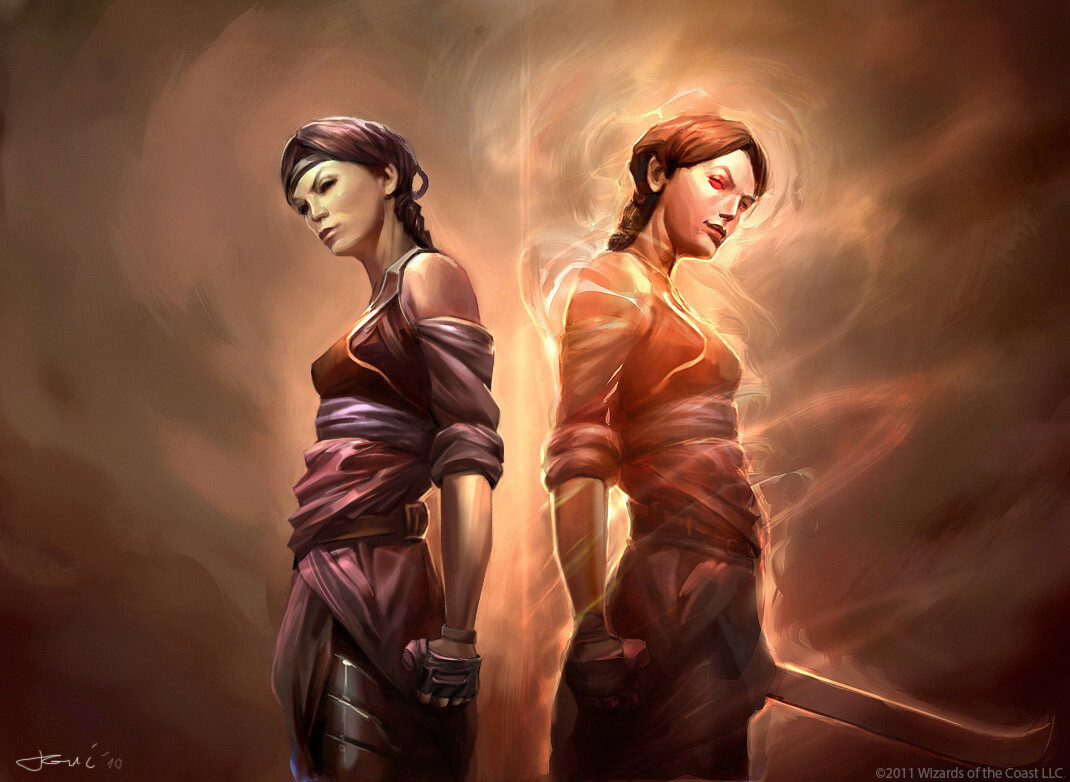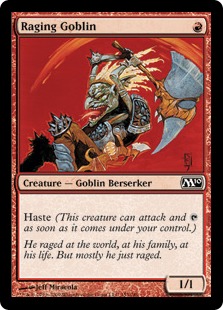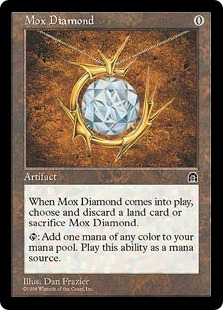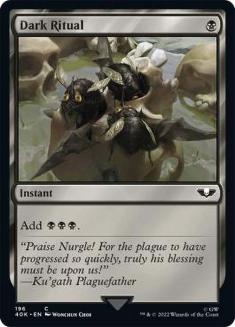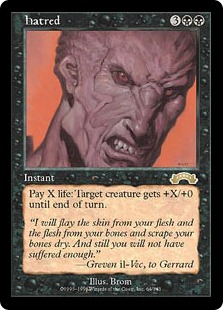Hello, and welcome to this installment of Sullivan’s Satchel. I’m fresh off covering the Magic Online (MTGO) Series 3…2019…championships? Or something? Wasn’t made entirely clear to me, but high-stakes Vintage Cube is a rare treat and Modern is the Constructed format I’ve been playing the most of recently, so I enjoyed the rounds.
In contrast to previous MOCS events I’ve covered, the pace of play was faster than “glacial” and we weren’t mired in ambiguous delays so everything ran smoothly, and the quality of play was very high, as expected. In particular, I’d like to congratulate Jan-Moritz Merkel for winning the whole thing after walking Cedric and me through his Cube strategy (easy 3-0), and to Daria Martins for making the no-equity bluff attacks from lost positions that I usually associate with grizzled, nihilistic MTGO veterans, not from someone who has had their account for under six months. I’m looking forward to watching you in the future.
My understanding is that this will be the first of many (all?) Satchels that will be published on the Select side of SCG. My philosophy here is that the website needs to make its money and I’m happy to fit in wherever makes sense, but all things being equal I’d rather produce stuff that can be enjoyed for zero dollars out of pocket. This column is also predicated on reader feedback so the more eyes, the better. Years ago I had some ego about being on the “paid side” but I’m much happier being here for as long as that’s the case.
With that, the questions. As always, you can send in yours to [email protected] or DM me on Twitter @BasicMountain. The best question as determined by me will win Question of the Week, along with $25 in SCG credit. With that,
From Kevin Bell:
Do Star City Games and Wizards have March Madness office pools? Is this something you’re into? If so, who’s in your Final Four?
Thanks,
Kevin
If either office does I’m not in the loop. Of the Play Design team at Wizards of the Coast (WotC), Michael Hinderaker and Adam Prosak are pretty big sports enthusiasts (though the latter has expressed ethical concerns around college athletics, so who knows) and Andrew Brown is willing to gamble on just about anything, but that doesn’t quite get you to the critical mass required to make a good pool. I would be stunned if something wasn’t available with some of the buyers/events people over at SCG (numerous sports fans, many of whom are from the hoops hotbed of North Carolina), but no one has reached out to me. Anyone over there reading this, feel free to reach out to me.
This has been the most engaged I’ve been with men’s college basketball since Kevin Durant’s lone season at Texas because my beloved Rutgers Scarlet Knights are dancing for the first time in 30 (!!!???) years. The woeful performance on the court was hard enough, but after the previous coach was fired for physical and verbal abuse, I kind of checked out for a few years. This year, the team has flirted with Top 25 status at various points and secured an at-large bid. They defend hard, they play connected, and they have two guys (Ron Harper Jr. and Geo Baker) who can get a bucket in crunch time. Their opening matchup with Clemson is very winnable (Vegas has Rutgers as slight favorites), and Houston’s resume feels light. Trying not to get too far ahead of myself but I’m failing.
As far as Final Four predictions, I have two rules.
- Trust the NBA-level freshman talent. I think a discrete, high-stakes tournament allows them to shine in a way that the grind of the regular season, which can sometimes be a challenge, doesn’t allow.
- Short Gonzaga. This applies in all years.
My Final Four:
- Iowa
- Alabama
- Baylor
- Oklahoma State
From Brandon Krussow:
How do you find Magic and its vernacular has impacted your personal life? I find my partner and I using phrases like, “Okay but what are our outs?” and, “Where’s the EV there?” In our everyday life for better or worse I guess.
Also thank you (and Cedric) for The Resleevables! I couldn’t be happier with the content, nostalgic feelings, and laughter.
Brandon Krussow
Mostly it’s been a massive negative influence. The vernacular of New Jersey Magic circa 2002 was so negative, abusive, homophobic, and really [anything]phobic that it required very active work from me to remove it from my vocabulary. Even now, hearing more “modern” slang, even stuff that’s relatively innocuous, I can’t help but get flashbacks to using that sort of language as a tool of gatekeeping and abuse. It also makes you incomprehensible to every functioning person once you indulge it past a certain point, which is another cost.
I think I draw more slang from other endeavors and cultures to Magic than the other way around; I think professional wrestling in particular has an incredible vocabulary that’s applicable in a bunch of places in Magic. Language from sports betting and competitive sports is broadly applicable as well.
I don’t think I’m being mindful enough because my kids are picking some of this up (I think my eldest said “bricked off” the other day) and I can’t countenance them becoming either inside-slang-spewing gremlins or “Plus EV” faux-financiers so, as usual, plenty of room for personal growth.
From Battle_On:
I think the color pie is always growing, adapting, and changing. There’s the sweet spot where you get all the upside of definition, tone, and incentives to build multicolored decks, without the downside of frustrating barriers or balance issues.
For example, I think Magic was too firm on the “blue draws cards” definition twenty years ago. Drawing cards is too foundational to the game engine to gate in such a way, but the call to action isn’t just to give everyone Concentrate — red can rummage, green can draw cards when creatures and/or lands are involved, white gets the occasional nod with stuff that cares about small creatures. I would say that all of this adds to the pie, not subtracts from it, so long as blue’s primacy and unconditional-ness of card drawing remains intact (to that end, I think Harmonize is a mistake, conceit of Planar Chaos notwithstanding).
I kind of wish blue did a bit less with scry — it isn’t the most satisfying thing to pair with card drawing (once you’re up some cards you’re usually in the market for both lands and spells, dampening the impact of scrying), and shifting that over more loudly to other colors could give a better angle for non-blue colors to get some smoothing/implicit advantage while still allowing blue to be the color of Divination. I wouldn’t want to remove it entirely because it’s such an easy add to things like Opt and such, but I wouldn’t mind shifting the distribution a little bit.
I wouldn’t mind trample being a bit louder in black; they’ve got a bunch of creature types and tropes that tonally fit and it’s fun with the +X/+0 or otherwise front-heavy pumps common in the color.
I’m also sold on more reach in red. I know Robber of the Rich gets panned as being weird and out of place but I see it more as proof-of-concept, not mistake. In terms of flavor, Mountains exist at a higher elevation than the other basic land types, so it isn’t that big of a stretch to come up with creature types and stories that facilitate reach, and red could use some defensive-oriented creature keywords. I don’t think a ton of reach is appropriate but some judicious, higher-rarity applications could be good without being dissonant or treading on green’s definition.
Lastly, the Question of the Week, from Tom Hickey:
(For the record, this question was sent in July of 2020, so the “recent Pioneer bans” is referring to something else, though still applicable here.)
I may have mentioned this before in a previous column, but it is possible to kill your opponent on the play, on the first turn, in Tempest Block Limited.
And no one thinks of Limited as being a place that should permit Turn 1 kills. Very few people know this is possible. No one cares, and I would bet considerable money its never happened in the real world — this exact hand, featuring multiple rares, happens so infrequently that even the threat of it happening doesn’t inform anyone’s experience.
The desire for firm parameters is going to create some blind spots and gaps that are more problematic than useful. If Modern is a “Turn 4 format,” that means that decks like Splinter Twin and Mono-Green Tron are never actionable no matter how good they are, and it means decks that aren’t particularly good but sometimes win on Turn 3 (Prowess, Burn, Infect, Storm, etc.) warrant significantly more scrutiny than their ubiquity and win rate would suggest. That doesn’t sound like a wise way to manage a banned list over the long haul.
It may have been useful to declare Modern as a Turn 4 format initially just to anchor expectations, but even if they never formally walked that statement back, it plainly doesn’t hold today; cards like Uro and Oko are about playing games well beyond four turns but should be out of bounds by any reasonable calculus. The format is better without them, so who cares if they abide by some “Turn 4” decree or not?
Something I’m getting a greater appreciation for is the fact that Play Design is aware of the next year or so of sets when making these calls. This cuts both ways; sometimes problems can hope to be solved and sometimes they can expect to get worse, but that’s an additional bit of context and information that the public doesn’t have when the calls get made.
In short, I think these kinds of degrees are more harm than good, and I’m happy WotC hasn’t made any similar decrees with Pioneer or Historic. “It should be a Turn 4 format” is a fine point to make internally, and can be one useful marker among many for making these calls, but the complexity of these decisions and their externalities are such that you should just use all the tools in the toolbelt, and not feel hamstrung by some arbitrary degree that only tangentially speaks to the overall experience.

